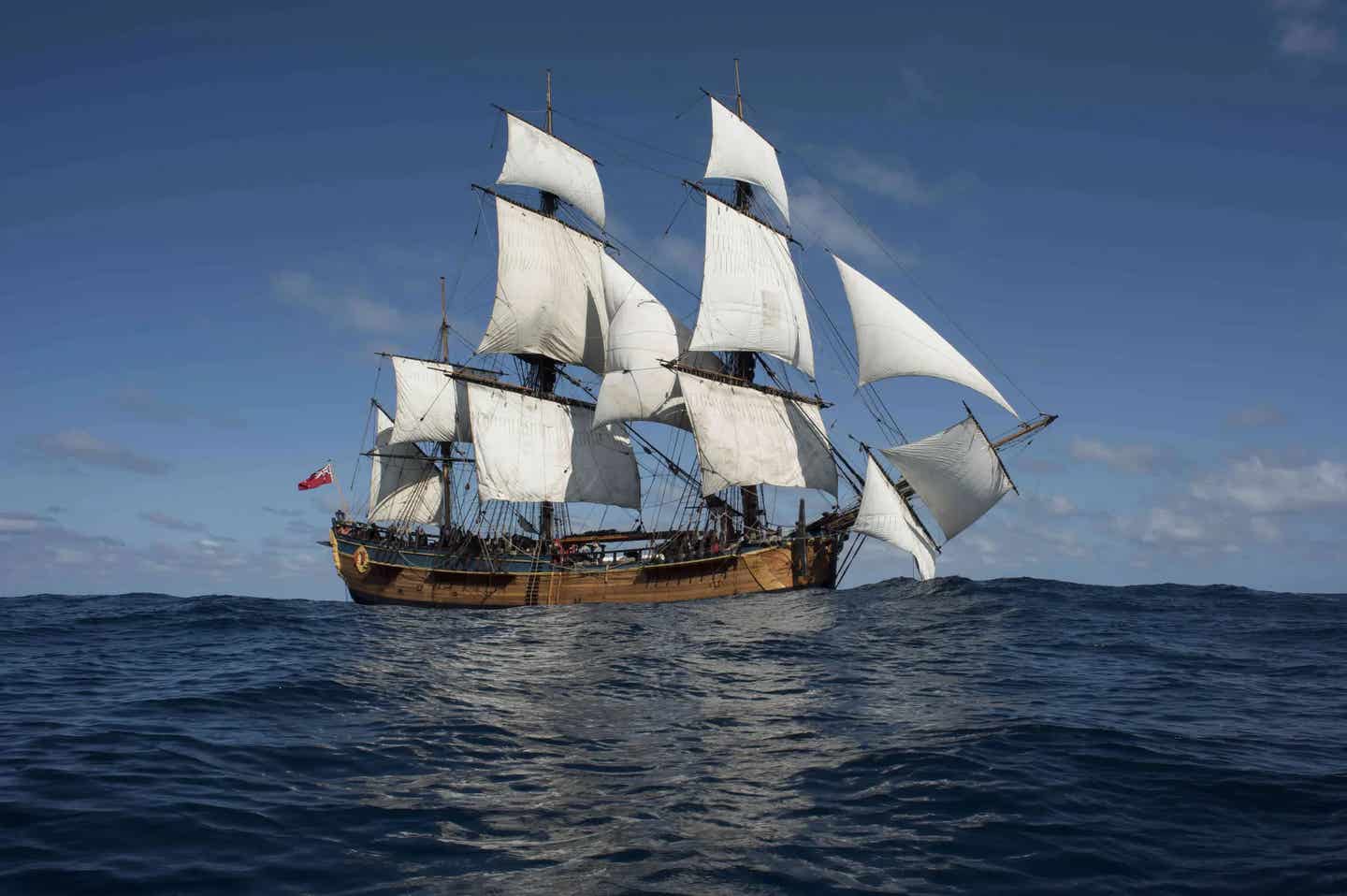Shipwreck of Captain James Cook’s HMS Endeavour finally discovered after 250 years
James Cook’s HMS Endeavour found after 250 years, ending a global maritime mystery beneath Newport Harbor.

James Cook’s HMS Endeavour, long lost to history, has finally been identified in Rhode Island, ending a 250-year mystery. (CREDIT: David Knight / ANMM)
For centuries, a ship that helped change history lay forgotten beneath the waters of Rhode Island. Now, the mystery surrounding James Cook’s famous vessel has finally been solved. After 250 years of speculation, research, and debate, the remains of the HMS Endeavour have been confirmed at the bottom of Newport Harbor.
This announcement ends one of the world’s longest-running maritime searches and connects an 18th-century journey of exploration with today’s science and technology.
From Coal Carrier to Scientific Icon
Endeavour began its life in 1764 as the Earl of Pembroke, a sturdy coal-carrying bark built in Whitby, England. It was built broad and flat, with a deep hold, ideal for storing provisions. The Royal Navy bought it for just over £2,300 to serve a grand purpose: to carry astronomers to Tahiti to observe the 1769 transit of Venus.
That task, however, was only the beginning. Under the command of James Cook, the ship set off in 1768 and circled the globe. It became the first European vessel to reach Australia’s east coast and to circumnavigate New Zealand. Its Pacific voyage helped usher in Europe’s Age of Enlightenment, but for many Indigenous communities, it marked the beginning of colonization and upheaval.
After its return to England in 1771, Endeavour faded from public view. The ship was soon repurposed by the British Navy as a troop transport. Later sold and renamed the Lord Sandwich, it served during the American Revolutionary War. By 1778, it had become a floating prison for American captives in Newport. That same year, it was deliberately sunk along with other ships to block the harbor and prevent a French-American assault.
Years of Research Beneath the Waves
The Australian National Maritime Museum (ANMM) has been on the trail of the Endeavour since 1999, working closely with the Rhode Island Marine Archaeology Project (RIMAP). Over two decades of dives, remote sensing, and artifact analysis followed.
Related Stories
A major breakthrough came in 2016 when ANMM researcher Dr. Nigel Erskine uncovered records narrowing down the likely scuttling location. Attention turned to a cluster of wrecks just north of Goat Island in Newport Harbor. Among them was one site that stood out: RI 2394.
Between 2017 and 2021, the team focused on this wreck. Measurements of the ship’s remains — 18.2 meters long and 7.3 meters wide — closely matched Endeavour’s recorded dimensions. The ship’s structure also featured paired and tripled floor timbers, a precise match for the positions of the original masts.
Then came a rare find. A unique timber joint, known as a “stem scarf,” matched the one on the Endeavour’s historic plans. "This stem scarf is also a very unique feature — we’ve gone through a whole bunch of 18th-century ship’s plans, and we can’t find anything else like it," said ANMM archaeologist Kieran Hosty.
Wood samples showed the hull had been repaired with British timber, just as records noted in 1776 after the ship was sold. These details — down to the millimeter — allowed the team to conclude that RI 2394 was, beyond doubt, the Endeavour.
A Ship With Two Lives
The transformation from explorer’s bark to transport and prison ship is often forgotten. In 1775, after sailing over 70,000 miles and undergoing several groundings, Endeavour was in poor shape. A naval survey described the decks as worn and many timbers as rotten. Repairs would have cost more than £3,400, and the ship was sold out of service for just £645.
Now under civilian ownership, Endeavour — renamed Lord Sandwich — was pressed back into military service. After transporting Hessian troops from Germany to New York, it ended up in Newport, Rhode Island. There, it served briefly as a prison ship before being sunk by the British to defend the harbor from a French fleet.
On August 3, 1778, Lord Sandwich was one of five transports scuttled between Goat Island and Blue Rocks. The goal was to block French ships from entering the harbor and bombarding British positions. The sunken ships remained undisturbed for more than two centuries.
In a 1779 report, the ship was listed among thirteen vessels sacrificed to this strategy. Drawings from the time even show the outlines of the blockships floating just beneath the harbor’s surface.
Resolving a Global Mystery
Not everyone agreed with the ANMM’s findings at first. When the museum released its preliminary results in 2022, RIMAP expressed concern, calling the announcement premature and in breach of contract. ANMM acknowledged RIMAP’s contributions and added that while their partner has not fully confirmed the wreck’s identity, they “continue to accept that RI 2394 may be Endeavour.”
But after comparing historic plans, matching the stem scarf, and analyzing timber, ballast, and hull structure, the ANMM says the case is closed. “You’ll never find a sign saying ‘Cook was here,’” Hosty said, “but we’ve got a whole series of things pointing to RI 2394 as being … Endeavour.”
James Hunter, another ANMM archaeologist, explained why some artifacts may never be found: “Anything that was of value would have been stripped out of that ship before it was sunk.” Still, the pieces recovered fit the right time period and match what is known about the ship’s design and refits.
With the evidence mounting and no signs pointing to a different identity, the team feels confident. “So far, we found lots of things that tick the box for it to be Endeavour and nothing on the site which says it’s not,” Hosty added.
The Legacy Lives On
The confirmation of RI 2394 as the Endeavour is more than a maritime win — it’s a moment of global historical reflection. For Australians, it’s a link to the nation’s colonial origin. For Americans, it’s tied to the Revolutionary War. For Indigenous peoples across the Pacific, it is a painful symbol of invasion and loss. For scientists and historians, it’s a remarkable recovery built on years of collaboration, patience, and care.
Securing the site will be the next step. Given its historical weight, RI 2394 must now be protected under strict preservation laws.
As Daryl Karp, director of the ANMM, said, “This final report is the culmination of 25 years of detailed and meticulous archaeological study on this important vessel.” With the wreck finally identified, the Endeavour’s journey may be over, but its story continues to resonate across oceans and centuries.
Note: The article above provided above by The Brighter Side of News.
Like these kind of feel good stories? Get The Brighter Side of News' newsletter.



